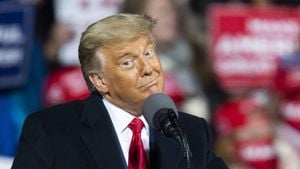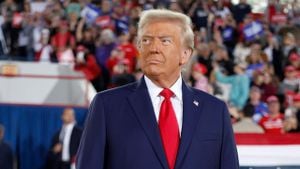The upcoming 2024 U.S. presidential election promises to significantly shape the future of American technology policy. Recent discussions around the CHIPS Act — legislation aimed at bolstering national semiconductor manufacturing — are bringing the debate over U.S.-China relations to the forefront. This debate has been amplified by prominent figures, including House Speaker Mike Johnson, who recently hinted at the potential repeal of the CHIPS Act if former President Donald Trump returns to the White House.
Initially, Johnson supported Trump’s technical agenda, which directly targets the CHIPS Act as part of their broader plan. The CHIPS Act, enacted to reduce dependency on foreign semiconductors, particularly those from China, has become central to U.S. attempts to maintain its technological edge. Yet, Johnson’s comments were pulled back just one day later—highlighting the growing unpredictability surrounding China-U.S. policies as the election approaches. This flux not only reflects political maneuvering but also signals larger questions about the efficacy and future of America's technological strategies.
At its core, the CHIPS Act is about more than just semiconductors. It embodies the U.S.'s attempt to decouple from China, recent years marked by rising tensions and strategic rivalry. By supporting domestic chip production, the U.S. aims to shield itself from supply chain disruptions seen during the COVID-19 pandemic. But as both sides navigate this tightrope, the long-term economic ramifications remain to be seen.
Critics of the decoupling strategy caution against the immediate focus on protective measures without considering the bigger picture. While isolative policies may seem beneficial in the short run, they risk hindering the U.S.'s global competitiveness. A core part of this strategy has involved distancing from Chinese markets, which serve not just as consumers of American tech but as integral players within global supply chains.
If the U.S. commits to returning to Trump-era policies, it could significantly challenge American businesses. These companies rely on access to China's massive and rapidly advancing markets—a cutback could lead to losses, increased operational costs, and even slower technological innovation.
Meanwhile, as American corporations face these policies, China is also strengthening its own resolve. With major investments directed toward developing its research and development capabilities, the nation is striving to become technologically self-reliant. Such advancements would ideally lessen its dependency on foreign technology, deferring the benefits of collaboration with the U.S.
The complexity of U.S.-China relations can't be overstated. Recent political narratives have painted China as the primary adversary, with each party vying for the edge during the campaign season. Current approaches often lean toward escalation rather than engagement—dangerous, especially considering the intertwined nature of both economies. Each side’s hard stance may lead to opportunities missed and potential growth stifled—a risk both nations can hardly afford.
Traditionally, the U.S. has placed great stock on the importance of collaboration for technological progress. Yet anti-China sentiment is prevalent, often deemed politically advantageous during domestic campaigns. Trump's populism and hardline stance toward China resonate with certain voter blocs, but this may come at the expense of potential trade and technology partnerships. If the current attitudes persist, it could hinder any hopes for improving relations between the two superpowers.
Key to resolving this standoff will be assessing whether the 2024 election can provide the impetus for reconsidering decoupling stances. A more balanced perspective might help align U.S. policies with the realities of economic interdependence. Acknowledging the complexity of bilateral ties may lead to constructive dialogue and innovation rather than continued division.
Looking back over the last four years, the U.S. and China will need to recalibrate their approach to negotiations, ideally choosing engagement over isolation. Without this reassessment, both economies could replace potential cooperation with prolonged conflict—a path fraught with uncertainties.
The American electorate faces pivotal choices this election season, not just concerning the immediate political climate but for the long-term direction of U.S. economic policy. With tech at the forefront, the next administration will shape the future of U.S. industrial strategy and its global standing. Will they opt for engagement over enmity? The stakes couldn’t be higher, both for Americans and for their counterparts abroad.



